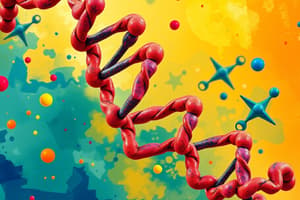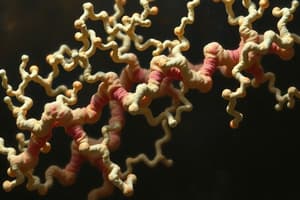Podcast
Questions and Answers
What term describes the linear sequence of amino acids in a protein?
What term describes the linear sequence of amino acids in a protein?
- Secondary structure
- Primary structure (correct)
- Tertiary structure
- Quaternary structure
Which structural level follows the primary structure of a protein?
Which structural level follows the primary structure of a protein?
- Tertiary structure
- Quaternary structure
- Secondary structure (correct)
- None of the above
How do functional groups impact protein functionality?
How do functional groups impact protein functionality?
- They stabilize quaternary structures.
- They determine the amino acid sequence.
- They contribute to enzymatic catalysis. (correct)
- They limit protein folding.
What type of change can alter a protein’s functionality?
What type of change can alter a protein’s functionality?
Which structures can proteins form at the quaternary level?
Which structures can proteins form at the quaternary level?
What is the unique feature of amino acids in relation to chirality?
What is the unique feature of amino acids in relation to chirality?
What process do nucleic acids use to code for proteins?
What process do nucleic acids use to code for proteins?
Which of the following statements is true regarding amino acids?
Which of the following statements is true regarding amino acids?
What is chirality as defined by Lord Kelvin?
What is chirality as defined by Lord Kelvin?
What is a racemic mixture?
What is a racemic mixture?
What are zwitterions in the context of amino acids?
What are zwitterions in the context of amino acids?
What effect does the pH level have on amino acids in solution?
What effect does the pH level have on amino acids in solution?
Why can Asx (B) and Glx (Z) amino acids create ambiguity in protein sequences?
Why can Asx (B) and Glx (Z) amino acids create ambiguity in protein sequences?
What is one potential future application of synthetic systems using R-amino acids?
What is one potential future application of synthetic systems using R-amino acids?
What commonly affects the properties of synthetic biomolecules using R-amino acids?
What commonly affects the properties of synthetic biomolecules using R-amino acids?
What specific aspect about amino acid sequences is important for protein function?
What specific aspect about amino acid sequences is important for protein function?
Which amino acid is known for its ability to readily gain and lose H+ ions at physiological pH?
Which amino acid is known for its ability to readily gain and lose H+ ions at physiological pH?
What is the importance of the sequence of a protein?
What is the importance of the sequence of a protein?
At physiological pH, what form does the side chain of aspartate normally take?
At physiological pH, what form does the side chain of aspartate normally take?
What characteristic is shared by aspartate and glutamate in proteins?
What characteristic is shared by aspartate and glutamate in proteins?
Which protein was the first to be fully sequenced, earning James D. Watson a Nobel prize?
Which protein was the first to be fully sequenced, earning James D. Watson a Nobel prize?
What is the pKa of a terminal amino group in amino acids?
What is the pKa of a terminal amino group in amino acids?
What role does methionine typically play in protein synthesis?
What role does methionine typically play in protein synthesis?
What flavor is glutamate known to provide in certain foods?
What flavor is glutamate known to provide in certain foods?
Which amino acid is unique for not being chiral?
Which amino acid is unique for not being chiral?
What type of bonds can cysteine residues form?
What type of bonds can cysteine residues form?
How many hydrophobic amino acids are listed in the content?
How many hydrophobic amino acids are listed in the content?
What non-standard amino acid can be encoded by the UGA stop codon?
What non-standard amino acid can be encoded by the UGA stop codon?
In terms of polarity, which statement is true about polar amino acids?
In terms of polarity, which statement is true about polar amino acids?
Which amino acid contains a pyrrolidine ring structure due to its unique properties?
Which amino acid contains a pyrrolidine ring structure due to its unique properties?
Which amino acid has a side chain that is considered polar and ionizable?
Which amino acid has a side chain that is considered polar and ionizable?
What distinguishes hydrophobic amino acids from others?
What distinguishes hydrophobic amino acids from others?
What defines an amino acid as essential for an organism?
What defines an amino acid as essential for an organism?
Which amino acid is known to modulate the mTORC1 complex?
Which amino acid is known to modulate the mTORC1 complex?
What is the implication of ample leucine levels in an organism?
What is the implication of ample leucine levels in an organism?
How can exercise influence appetite according to the functions of phenylalanine?
How can exercise influence appetite according to the functions of phenylalanine?
What role does SOD1 play in cellular function?
What role does SOD1 play in cellular function?
What kind of mutations can precipitate severe consequences related to ALS?
What kind of mutations can precipitate severe consequences related to ALS?
In the context of gene mutations, what is the term used to describe the variability in disease onset and progression?
In the context of gene mutations, what is the term used to describe the variability in disease onset and progression?
What is the function of glutamate in the nervous system?
What is the function of glutamate in the nervous system?
Flashcards are hidden until you start studying
Study Notes
Protein Structure and Function
- Proteins are essential biomolecules involved in various biological processes like replication, homeostasis, structural support, cell signaling, and developmental coordination.
- Nucleic acids code for proteins in a linear fashion, where each nucleotide triplet corresponds to one amino acid.
- The linear sequence of amino acids, called the primary structure, folds into secondary structures like alpha helices and beta sheets.
- These secondary structures interact and form the tertiary structure, the final folded form of the polypeptide.
- Multiple proteins can assemble into larger complexes like homodimers, heterodimers, and tetramers, representing the quaternary structure.
- The 3-dimensional structure of proteins can be determined using X-ray diffraction, providing insight into protein function and activity.
- Functional groups within amino acids contribute to protein-driven enzymatic catalysis.
- Major functional groups in amino acids include carboxyl (OH-C=O), amino (NH2), and the variable R group.
- Proteins interact with other molecules like nucleic acids, lipids, and polysaccharides, shaping cellular processes.
- Proteins can undergo conformational change, altering their functionality and interactions.
Amino Acid Structure and Properties
- There are 20 standard amino acids used in all living organisms.
- Each amino acid is characterized by its unique R group, which defines its chemical properties.
- Amino acids are chiral molecules, existing as L (Laevorotatory) or D (Dextrorotatory) isomers.
- All life on Earth utilizes L-amino acids.
- In aqueous solutions, amino acids exist as zwitterions, containing both positive and negative charges.
- Outside the physiological pH range, amino acids can exist in non-dipolar forms, with both sides protonated in acidic conditions and deprotonated in basic conditions.
- Amino acid abbreviations are crucial for avoiding ambiguity in peptide sequences.
- The sequence of amino acids determines the structure and function of proteins.
- The first protein to be fully sequenced was insulin.
- Edman degradation was instrumental in sequencing numerous proteins.
- Protein sequence knowledge facilitated the understanding of the Central Dogma (DNA -> RNA -> Protein).
Amino Acid Groups and Properties
-
Hydrophobic Amino Acids:
- Contain alkane chains
- Repelled by water molecules
- Important for protein folding and membrane interactions
-
Methionine:
- Often the first amino acid in a protein
- Corresponds to the start codon ATG
- Found in both prokaryotes and eukaryotes
-
Proline:
- Unique structural property connecting back to the amino group
- Forms a pyrrolidine ring
- Impacts protein flexibility and folding
-
Glycine:
- Non-chiral
- Provides flexibility in protein structures
-
Polar Amino Acids:
- Uneven electron distribution
- Partial charges attract water molecules
- Often found on the surface of proteins
-
Cysteine:
- Can form disulfide bridges, covalent bonds that stabilize protein structure
- Highly reactive, often found inside proteins
-
Histidine:
- Found near active sites of enzymes
- Imidazole group facilitates protonation and deprotonation at physiological pH
- Important for enzyme catalysis
-
Aspartate/Aspartic Acid:
- Negatively charged at physiological pH
- Typically found on the surface of proteins
-
Glutamate/Glutamic Acid:
- Negatively charged at physiological pH
- Contributes to umami flavor in food
-
pKa:
- Represents the pH at which 50% of a substance is deprotonated
- Helps predict the protonation state of amino acids at different pH values
Essential Amino Acids
- Essential amino acids cannot be synthesized by the organism fast enough and must be obtained from the diet.
- The essentiality of an amino acid can vary depending on the organism.
Additional Roles of Amino Acids
- Amino acids play critical roles beyond protein synthesis.
- They maintain nitrogen homeostasis.
- They can be metabolized for energy.
- They serve as signaling molecules and neurotransmitters.
Example of Amino Acid Changes in Disease
- SOD1 is an enzyme crucial for protecting against free radicals.
- Mutations in SOD1 can lead to ALS (Amyotrophic Lateral Sclerosis) and motor neuron disease.
- Single amino acid substitutions can have dramatic effects on protein function and lead to disease.
- ALS highlights the complex relationship between genetics, disease phenotypes, and the variability in disease progression.
Studying That Suits You
Use AI to generate personalized quizzes and flashcards to suit your learning preferences.



